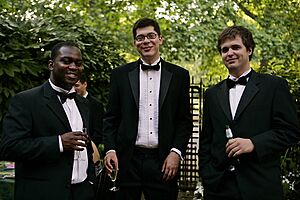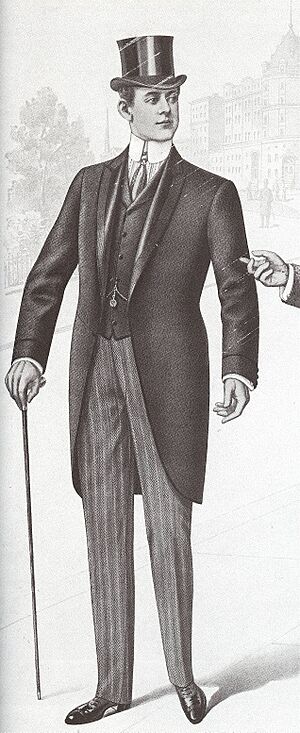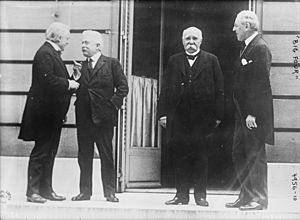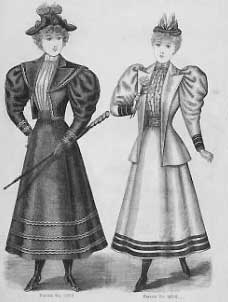History of suits facts for kids
A suit is a set of clothes made from the same fabric. It usually includes a jacket and trousers, and sometimes a waistcoat (vest). This article will tell you about the history of the modern suit, often called a business suit when it's dark and simple.
Contents
The History of Men's Suits

Suits have been a traditional type of men's formal clothing in Western countries for centuries. For about 400 years, suits with matching coats, trousers, and waistcoats have gone in and out of style. The modern suit we see today comes from the fancy, colorful clothes worn in royal courts in the 1600s.
The modern suit first appeared in the late 1800s. However, its roots go back to 1666, when King Charles II of England decided men in his court should wear a long coat, a waistcoat (then called a "petticoat"), a cravat (like a necktie), a wig, knee breeches (short trousers), and a hat.
Suits in the Early 1800s
In the early 1800s, a British fashion leader named Beau Brummell made the British court style popular across Europe. Important European men started wearing well-made, tailored suits that look a bit like what we see today. These new clothes were simple and dark, very different from the flashy styles before. Brummell's ideas led to the modern suit jacket, long pants, and necktie.
During this time, Brummell introduced a popular style for daytime. It included a tight, dark tailcoat with trousers that didn't match (usually light-colored), a light waistcoat, a white shirt, a cravat, and tall boots.
Victorian Era Suits
As the Victorian period began, the frock coat became very popular. It was a long coat that quickly became the standard daily wear for gentlemen. By the mid-1800s, a new, less formal coat called the morning coat became acceptable. It had a cut-away front, which was good for riding horses. These coats were not considered "suits" because they were worn with trousers that did not match the coat's color or fabric.
Towards the end of the 1800s, the modern lounge suit was created. It was meant to be very informal, only for sports, country trips, or seaside visits. The lounge jacket came from a coat style called the paletot, which was a loose coat without a waist seam.
Around the same time, the dinner jacket was invented for informal evening events, starting in 1888. It came from the very formal white tie dress code. This new style was first called 'dress lounge' and later became known as black tie. When it came to the United States, it was called the tuxedo. At first, 'dress lounge' was only for small private gatherings. But it slowly became more popular for bigger events as an alternative to the very formal white tie.
Edwardian Era Suits
The start of the Edwardian era in the early 1900s saw the frock coat become less popular. The suit we know today began to take shape. The tailcoat also started losing popularity among upper classes in the United States and Europe. Meanwhile, the morning suit became more formal. It was first accepted for businessmen, then became standard dress for upper classes.
The lounge suit slowly became acceptable outside its original casual settings and started to be seen in towns. Black tie became more common, though it was still mostly for private gatherings without ladies.
In North America, a type of lounge suit called the "sack suit" became very popular. This suit was loose and informal, without darts (sewn folds) to shape it, except at the shoulders.
Suits Between the World Wars
After World War I, most men started wearing the short lounge suit. Long coats quickly went out of fashion for everyday and business wear. The morning coat then became known as "formal" wear. In the 1920s, short suits were worn for almost all occasions, except for formal daytime events where a morning coat would be used.
For evening events in North America, the short dinner jacket mostly replaced the long "full dress" tails. Black tie became the main evening wear, with white tie saved for only the most formal events. In Britain, black tie became an acceptable informal choice instead of white tie.
In the 1920s, men started wearing wide, straight-legged trousers with their suits. These trousers were often 23 inches around the cuff. Younger men sometimes wore even wider trousers called "Oxford bags." Trousers also started to be worn with cuffs after World War I. They also began to be creased in the 1920s. Trousers were worn very high-waisted throughout the 1920s and into the 1940s.
Single-breasted suits were popular in the 1920s. The double-breasted suit was mostly worn by older, more traditional men. Fashionable men in the 1920s often wore double-breasted waistcoats with single-breasted coats. Lapels on single-breasted suits were wide and peaked. These styles continued and even became more extreme in the early 1930s.
Before 1935, men liked snugly tailored coats and waistcoats. But in 1935, styles changed completely. Loose-fitting coats were introduced, trousers became narrower at the bottom, and suit coats had tapered arms. These new trends were not easily accepted at first. The waistcoat stayed fitted for a while, but by 1940, it also became loose, making it uncomfortable. Fashionable men then preferred the double-breasted suit coat, which stayed in style for the next two decades.
By this time, morning dress was being replaced by a daytime semi-formal style called the stroller in North America. This was quite popular. In modern times, the black lounge suit has become popular for daytime wear.
Suits After World War II
After World War II, suits became more standardized and simpler. Suit coats were cut straight, without a clear waistline. By the 1960s, lapels were narrower than ever before. War-time fabric rationing had forced big changes in style, making cuts like the double-breasted suit less popular.
The New York Times Style Magazine described a famous suit from this time, the gray flannel suit:
In 1955, a novel called The Man in the Gray Flannel Suit made this classic men's suit a symbol of boring, middle-class life. Flannel was originally a simple woolen cloth. In the 1880s, white flannel was used for summer sports. By the 1920s, gray flannel became a favorite. When the Prince of Wales wore gray flannel trousers in America in 1924, college students copied him. Famous actors like Cary Grant and Fred Astaire kept the trend going into the 1940s.
In the late 1960s and early 1970s, the Nehru jacket, an Indian style with a mandarin collar, became briefly popular in Western countries. Entertainers like Johnny Carson and The Beatles wore it.
In the 1970s, a snug-fitting suit coat became popular again, bringing back the waistcoat. This new three-piece style became linked with disco culture, especially after the movie Saturday Night Fever.
The 1980s saw suits become simpler again. The jacket became looser, and the waistcoat was mostly gone. A few suit makers still made waistcoats, but they were cut low and often had only four buttons. The waistline on the suit coat moved down again in the 1980s. By 1985-1986, three-piece suits were going out of style, replaced by cut double-breasted and two-piece single-breasted suits.
In the late 1990s, the three-button two-piece suit became popular again, but then went out of fashion in the early 2000s.
Women's Suits
The first women's suits were riding habits, which included a tailored coat or jacket and a matching skirt from the 1660s. These were practical and strong, worn for riding horses, travel, and other daytime activities. Jacket-and-skirt outfits not meant for riding appeared later in the 1800s.
In the first half of the 1900s, the skirted suit became common daytime city wear for women, both at work and outside. dressmaker suits used softer fabrics and more "feminine" details. cocktail suits were worn for semi-formal events in the mid-century. The Chanel suit was a popular business outfit in the 1950s and 1960s.
Yves Saint Laurent introduced his "Le Smoking" tuxedo suit in 1966. This shocked the fashion world because it was a two or three-piece suit designed specifically for women.
Pantsuits (women's suits with trousers) were introduced by designer André Courrèges in 1964. They were slowly accepted as business or street wear. With the rise of the feminist movement in the late 1960s, pantsuits became acceptable office wear in the early 1970s. A white-collar woman's suit of a skirt, tailored shirt, and floppy tie became popular in the 1970s and 1980s.
Modern Suit Styles
Even though the tailored suit is often seen as a very traditional Western outfit, different styles have been adopted by many groups over the last century. These styles often show off fashion or social identity.
Some non-traditional suit styles from the past century include:
- The Jazz suit of the early 1920s was very high-waisted and tight-fitting. The trousers were short, showing the wearer's socks.
- The Zoot suit of the late 1930s and 1940s.
- The Western suit, which is a type of western wear with a tailored jacket and "western" details like pointed yokes or arrowhead pockets.
- The Nudie suit, a very decorated type of western wear.
- The Ivy League style of simple, plain suits and casual clothes was popular for young men from the mid-1950s to the late 1960s.
- The Beatle suit, inspired by Pierre Cardin's collarless jackets.
- The Mod suit, a fashion from the 1960s and again in the early 2010s. It had a very slim cut, narrow lapels, three or four buttons, and a very narrow waist.
- The Safari suit, a fashion from the 1970s. It was based on military uniforms worn in hot places. It had trousers and a short-sleeved jacket with patch pockets, usually in light colors like beige or pastel blue and green.
- The Disco suit, a 1970s fashion with wide lapels and flared trousers. It often didn't have a necktie and was made of white or brightly colored polyester fabric. This style was famously worn by John Travolta in the 1976 film Saturday Night Fever.
- The short-lived leisure suit also appeared in the 1970s. It had a matching jacket and trousers in less formal fabrics and colors than business suits.
- The Power suit of the mid-1980s and early 1990s: a double-breasted suit with sharp cuts, wide shoulder pads, and a stiff look.
See also
- Mao suit






